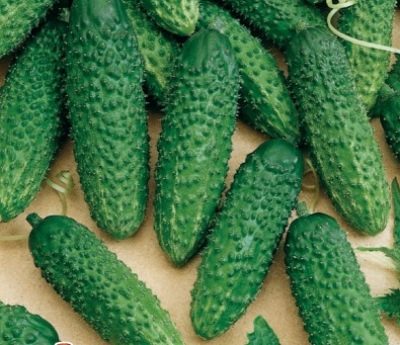
- Authors: Borisov A.V., Krylov O.N., Orekhova E.A.
- Year of approval: 2004
- Growth type: vigorous, indeterminate
- Branching: the average
- Fruit weight, g: 90-110
- Fruit length, cm: 9-12
- Fruit color: green with medium stripes
- Cucumber Mosaic Virus Resistance: stable
- Fruit shape: fusiform
- Fruit taste: excellent, no bitterness
Junior lieutenant is a variety of cucumbers that is distinguished by unpretentiousness and productivity. Consider how to plant it correctly, grow it and protect it from pests.
Breeding history
The variety emerged as a hybrid in 2003 thanks to the efforts of domestic breeders A. V. Borisov, O. N. Krylov, E. A. Orekhova. The next year, the Junior Lieutenant was entered into the State Register of Russia.
Description of the variety
The hybrid is considered parthenocarpic; it does not have its own seeds. It is chosen for growing in open ground or using a film cover.
Characteristics of the appearance of plants and zelents
The plant is classified as vigorous and indeterminate. The junior lieutenant has medium branching and medium-sized leaves with faint waves along the edge. The bushes have a female type of flowering, and the volume of greens in one bunch varies from two to seven pieces or more. The hybrid has a good ability to form shoots, so it needs formation.
Fruits reach 9-12 cm in length and 3 cm in diameter. Fruit weight - 90-110 g. Cucumbers have a medium lumpy surface of pleasant green color.
Purpose and taste of fruits
The variety has a universal purpose. The taste of the fruit is excellent, without bitterness.
Maturation
Junior lieutenant is a variety that will not keep itself waiting long. It belongs to the early, and the period from its first shoots to the beginning of the formation of the crop takes on average 40-42 days.
Yield
The bushes have high yields. From one square meter, the variety gives from 9 to 14 kg.
Growing regions
Cucumber can most often be found in the regions of central Russia.
It is also grown in the following regions:
- North;
- Northwest;
- Central;
- Volgo-Vyatsky;
- TsCHO;
- North Caucasian;
- Middle Volga.
Landing scheme
When planting plants in a greenhouse, there are a maximum of 4 bushes per 1 m2. So, in the aisles and between the bushes, the distance will be about 50 cm. When planting in open space, the plants need a little more space.
Growing and care
The necessary type of soil for the cultivation of this culture, according to gardeners, will be medium loamy. It is important that the ground is well permeable to water. Site preparation begins in the fall by digging and fertilizing.
The seeds of the Junior Lieutenant can be planted both in open ground and by seedling. In the first option, the land should warm up to at least +15 degrees, the landing begins at the end of May. Cucumbers need to be diligently watered with warm, settled water (in the morning or in the evening), loosened and weeded the ground, fertilize in a timely manner. The frequency of top dressing is once every 14 days.
The seeds of this hybrid do not require pre-planting treatment. Work on growing seedlings begins at the end of the first spring month.
The seeds are germinated as follows.
- The material is immersed in warm (+ 30-40 degrees) water, waiting for them to swell.
- The seeds are wrapped in a wet cloth and left for 1-2 days in a dark, warm place.
- After the roots appear, the seeds are planted in peat pots, special cassettes or plastic cups prepared in advance. Peat, humus and sawdust are introduced into the ground. Sufficient depth for seeds is 2 cm.
- Seedlings are watered abundantly and left in a room with a temperature of no higher than 20 degrees.
Mineral fertilizers are applied after watering. The first feeding is carried out after two weeks after the first shoots, the second one - 1-2 days before transferring to the ground. In 2 weeks, the plants begin to harden, bringing the bushes outside. Seedlings can be transplanted if there are 2-3 full leaves on each sprout.

In order to collect strong, tasty and beautiful cucumbers on your site, you need to make top dressing. Lack of nutrients can negatively affect the appearance of the plant and significantly reduce the yield. Fertilize cucumbers with organic fertilizers in combination with mineral fertilizers. With the right balance of these components and adherence to the fertilizing schedule, the cucumber yield will be maximum.
Disease and pest resistance
The variety has good immunity.
It is resistant to:
- cucumber mosaic virus;
- cladosporiosis (brown olive spot);
- powdery mildew.
In case of damage to downy mildew, the plants are covered with dark green and slightly gleaming spots that can grow over time. Affected leaves and stems are cut and discarded. The bushes are sprayed with systemic fungicides.
Gardeners do not recommend using cold water when watering: this provokes the development of root rot in the plant. They also advise tying cucumbers vertically, on nets or twines, to prevent the development of ailments and catch pests. From the latter, plants are treated with solutions and preparations. Most often, aphids, nematodes, snails and slugs will burrow on cucumbers.

Despite their popularity, cucumbers are often attacked by diseases and pests. From them, cucumber plantings often die before the start of fruiting. In order to prevent this from happening, it is necessary to try to prevent ailments or get rid of them at the very beginning, having studied in detail their causes of occurrence, signs and methods of treatment.





























































































